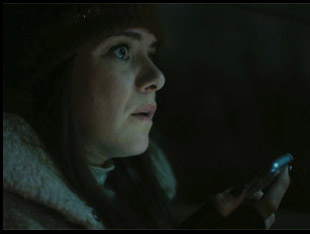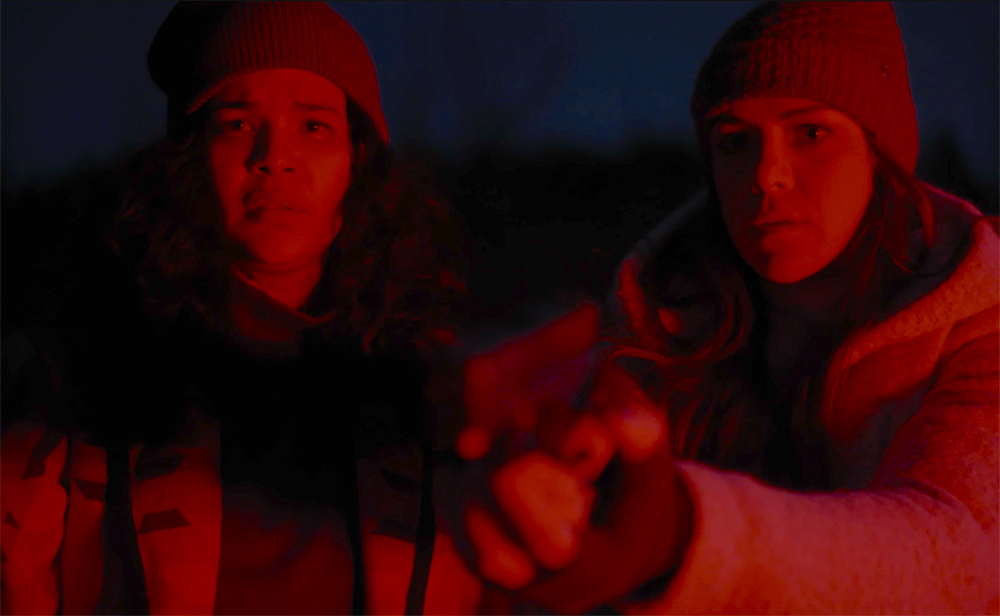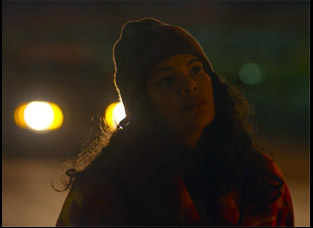When Eva Thomas first started out in the film business with plans to become an actress, she couldn’t help but be surprised when her agent asked if she knew anything about horses.
“Because if I wanted to work as a native actress in Hollywood, I would have to learn how to ride a horse,” says Thomas, who was unaware that this would be a necessary skill after training at the American Academy of Dramatic Arts in New York and the Webber Douglas Academy of Dramatic Art in London. “And I [thought], ‘Oh my God,’ but he was also right because of all the leather and the feather gigs that was all that was made available to me in that time. So then I started to think I should start to write.”
Thomas has spent much of the past decade helping others see their scripts through to the screen as a story editor at the Imaginative Features Lab, but she has finally carved out the time to work on her own with “Redlights,” her directorial debut that will be premiering as part of the shorts program at this year’s Toronto Film Festival. After sitting next to Danis Goulet on the set of “Night Raiders” as an associate producer, Thomas has made something just as muscular with the taut tale of Tina (Kaniehtiio Horn) and Amber (Ellyn Jade), a pair of Indigenous women out for an evening of winding down after a long week at their local watering hole when Amber mysteriously disappears and rather than to help with the case, the arrival of the police on the premises makes it look like they’re the main suspects.
In the dead of night, Thomas shines a light on the real-life travesty known as “Starlight Tours” in the indigenous community where a lack of jurisdictional clarity allows cops to act with impunity, with some reported cases of luring women to their deaths. There may be no one coming to the rescue of Tina and Amber in “Redlights,” but the writer/director shows how the women can depend on each other in the most dire of circumstances and while she has bigger plans for the pair, the short packs a punch as Tina is thrust into a desperate search for her friend. Shortly before the film’s premiere at TIFF, the filmmaker spoke about getting crafty in casting to land the “Letterkenny” stars for her first narrative film, getting a dynamic visual style in the dark and her plans to develop the short into a feature.
I had the good pleasure of doing the Indigenous Story Editing Mentorship at the Harold Greenberg Fund, which was a partnership between Imaginative and the then Harold Greenberg Fund, and I spent nine or ten months reading stories, giving notes on scripts, and being in the room when they decided who got money. Through that process, I was able to see that one path to directing a feature film was to make a really good short. Then I was on “Night Raiders” as an associate producer and I got to see Danis Goulet direct. “Night Raiders” also had a short film version of it, so I [thought], “Okay, that seems to be a pretty successful path.” So here we are with a short film I’ve made which is going to premiere at TIFF [like “Night Raiders”] and I’m working on the feature film script now.
What actually drew you to this idea?
I was inspired by the iconic film “Thelma and Louise,” and I remember watching it as a child and in my little child brain thinking, “Why don’t they just go to the police?” Then when I got to watch it as an adult a handful of years ago, I could see so many more layers to it [about] why they couldn’t and it being Texas, and then I thought to myself, “Wow, if those two women couldn’t go to the police, what would it be like if it was two indigenous women?” The feature film is like an indigenous “Thelma and Louise” [with] two indigenous women on the run who got in trouble with the law, and the short is [about] the trouble that they get into [in the first place]. Certainly, the Starlight Tours were something that was in my consciousness as an indigenous person, but what I’m learning is a lot of people aren’t aware of it, so I’m able to tell this story, but also do a little bit of education at the same time.
Did you have locations in mind as you were writing? It seems like the story might’ve been informed by the geography.
We shot it in the GTA and I didn’t think that was possible because I kind of needed this remote area in space. We shot two days in Mississauga for the interior and exterior of the bar, and some of the driving scenes. And then we went out to the Clairville Conservatory, which is north of the Toronto airport and when you get deep enough into that land space, it does feel quite remote. It was really good because I could use the talent that’s in the GTA and their expertise and experience, but at the same time, we got that remote feeling that I needed for the film. I was also really conscious not to name the place in the short because historically these things have taken place out West, like in Saskatchewan. But what I also was a little bit surprised to hear is that they also take place in Northern Ontario. One of the actresses, Ellyn Jade, who played Amber, talked about how something like this happened in her community, so it even opened up my eyes to thinking, this is something that happens more broadly and although three deaths have been reported, many more people have experienced it and were afraid to to report it.

It’s interesting because I run the Imaginative Features Lab and we’re in our fifth year and I take four indigenous writers a year — two Canadian and two international and take them through like a nine-month process where we go from, “I have an idea for a feature” to treatment [through] a second or third draft. I had the good pleasure to work with Kaniehtiio in the third year of that lab and got to know her. I also worked with her on her project called “Seeds” as a story editor and then eventually as an executive producer, and we just shot that up in North Bay. So I developed a bit of a relationship with her and Kaniehtiio had posted a picture of [herself] and Ellyn on her Instagram page — they both work together on “Letterkenny” and when I saw that picture, I was like, “Oh yeah, that’s [these two characters in ‘Redlights’].”
So when I had a script ready to share, I sent it to Kaniehtiio, and I said, “I always really saw you in this role” and luckily she liked the script and she graciously agreed to do it, but I was smart about it. I put together a little pitch deck and had included that picture of her and Ellyn Jade. And she said to me, “I always loved that picture of me and Ellen Jade.” And I was like, “Well, it’s funny you should say that because I always imagined you two in the film.” [laughs] She said, “Really?” Let’s send [the script] to her.” And luckily Ellyn Jade liked it and also agreed to do it. They’re friends in real life, and I was hopeful that that energy would imbue itself in the film, and I think that it did.
I knew I needed the audience to care about them and to believe in their friendship — that someone would go that far to help someone else, so I just had this gut instinct that that dynamic would work and because they are real friends, they had a good time on the set together. And then Jennifer Podemski is one of my mentors and I asked her to come in to voice the mother, so I couldn’t have asked for a more talented and experienced stars than I got. I just got really blessed and I felt really lucky.
When I heard Jennifer’s voice, I thought I know that voice from somewhere.
In the editing process, we just had a temp voice and the voice wasn’t that bad, but when Jennifer came in and she did the voice, because she’s a mother herself, I just knew that it would add this sense of urgency. What I really needed in the film was for people to understand that somebody cared about these indigenous women and that they were loved. A lot of times when you think of missing and murdered indigenous women, people perhaps think that they’re throwaways of society, but I really wanted these two women to be cared about, and Jennifer really helped to convey what I was hoping to achieve.
This is both formally and thematically different than the other directing work you’ve done. Did it feel different?
This short film is my first launch into directing narrative. I’ve done a few documentaries for my community, Walpole and First Nation, and directed for CBC’s “Still Standing,” which is a docu-series. What I was able to glean from those experiences is being the leader of the ship. As a director, you’re the leader of the ship no matter what the format is and I could really tip my hat to [those previous experiences] getting really comfortable in that space, leading a crew and making decisions and having a vision. Certainly in “Redlights,” I’m working with a script and with actors and I had never done a stunt before. The producers, when we were in prep, [were saying], “It’s really hard.” And I didn’t know it was going to be as hard as it was, just because you’re worried about everyone’s safety and you also have limited time because in a few hours, that sun’s going to come up and then you’re done. So it was a new experience and not only was I hoping to have like a calling card for the short to features, but I wanted the film to launch me as a director in the narrative space as well.

Alan Bacchus, one of my producers, had connected me with Michael LeBlanc, who’s the director of photography, and the first week we sat down and he [asked], “What are you trying to do?” And I said to him, “I just need this to feel cinematic.” The film is, of course, called “Redlights,” and the theme of red is something we in the indigenous community use as a symbol for missing and murdered indigenous women, so it was something that I consciously had weaved into the the script and into the visual language of the film — [Amber]’s wearing a red jacket and we’re chasing those red lights through the dark. And Michael got it right away, and I was able to lean into his experience as a new director, and the fact that he really trusted my vision and I really trusted his expertise, we worked really nicely together.
And now the film is premiering in Toronto. What’s it like getting to this point with it?
We shot this in November over three days last year and when we were on set, I would tell people — joking, but not really — “Next year, when we premiere at TIFF…” I always feel like I’m using the sheer force of my own will to tell the universe this is what I wanted and then the universe luckily delivered. I also was in Berlin this past year and I knew Jason Anderson, who [programs] the short films would be there and I got to sit down with him and I told him about my film and why I was making it, just wanted to put a face and a person and a spirit behind the application [I’d eventually send]. But I still wasn’t sure that I would get in. I was just talking a bunch of game. Then when I got the e-mail, I was like, “Oh my God, oh my God, oh my God, oh my God!” I must have said it like a hundred times. And then I jumped out of my room and went looking for people and then there was no one home, so I had to be in that moment by myself. Then something that just got announced is that TIFF invited me to their Filmmakers Lab, so my short film will premiere at TIFF and then I’ll be in the Filmmakers Lab talking about the feature that I’m trying to make, so I guess if you say [something] enough to the universe, the universe will deliver. And it’s a kind of a big deal [since] I’m new to that directing narrative space that they must see something in the film and in the stories I want to tell that’s worth supporting and for my short film to have this kind of reception [already], and for it to be invited to TIFF, I’m really grateful.
“Redlights” will screen at the Toronto Film Festival as part of Short Cuts Program #2 at Scotiabank 14 on September 8th at 6:50 pm and September 12th at 11:30 am.





